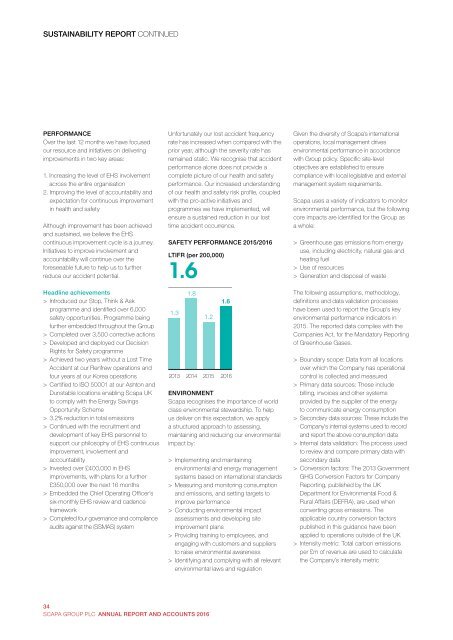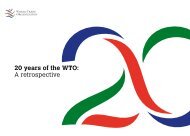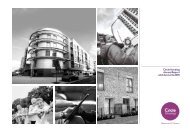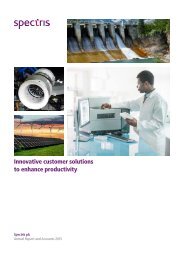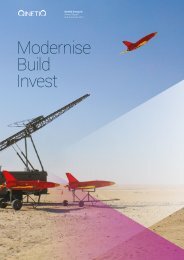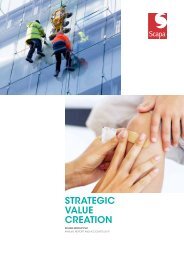20645_Scapa_AR_160504
You also want an ePaper? Increase the reach of your titles
YUMPU automatically turns print PDFs into web optimized ePapers that Google loves.
SUSTAINABILITY REPORT CONTINUED<br />
PERFORMANCE<br />
Over the last 12 months we have focused<br />
our resource and initiatives on delivering<br />
improvements in two key areas:<br />
1. Increasing the level of EHS involvement<br />
across the entire organisation<br />
2. Improving the level of accountability and<br />
expectation for continuous improvement<br />
in health and safety<br />
Although improvement has been achieved<br />
and sustained, we believe the EHS<br />
continuous improvement cycle is a journey.<br />
Initiatives to improve involvement and<br />
accountability will continue over the<br />
foreseeable future to help us to further<br />
reduce our accident potential.<br />
Headline achievements<br />
> > Introduced our Stop, Think & Ask<br />
programme and identified over 6,000<br />
safety opportunities. Programme being<br />
further embedded throughout the Group<br />
> > Completed over 3,500 corrective actions<br />
> > Developed and deployed our Decision<br />
Rights for Safety programme<br />
> > Achieved two years without a Lost Time<br />
Accident at our Renfrew operations and<br />
four years at our Korea operations<br />
> > Certified to ISO 50001 at our Ashton and<br />
Dunstable locations enabling <strong>Scapa</strong> UK<br />
to comply with the Energy Savings<br />
Opportunity Scheme<br />
> > 3.2% reduction in total emissions<br />
> > Continued with the recruitment and<br />
development of key EHS personnel to<br />
support our philosophy of EHS continuous<br />
improvement, involvement and<br />
accountability<br />
> > Invested over £400,000 in EHS<br />
improvements, with plans for a further<br />
£350,000 over the next 16 months<br />
> > Embedded the Chief Operating Officer’s<br />
six-monthly EHS review and cadence<br />
framework<br />
> > Completed four governance and compliance<br />
audits against the (SSMAS) system<br />
Unfortunately our lost accident frequency<br />
rate has increased when compared with the<br />
prior year, although the severity rate has<br />
remained static. We recognise that accident<br />
performance alone does not provide a<br />
complete picture of our health and safety<br />
performance. Our increased understanding<br />
of our health and safety risk profile, coupled<br />
with the pro-active initiatives and<br />
programmes we have implemented, will<br />
ensure a sustained reduction in our lost<br />
time accident occurrence.<br />
SAFETY PERFORMANCE 2015/2016<br />
LTIFR (per 200,000)<br />
1.6<br />
1.3<br />
1.8<br />
1.2<br />
1.6<br />
2013 2014 2015 2016<br />
ENVIRONMENT<br />
<strong>Scapa</strong> recognises the importance of world<br />
class environmental stewardship. To help<br />
us deliver on this expectation, we apply<br />
a structured approach to assessing,<br />
maintaining and reducing our environmental<br />
impact by:<br />
> > Implementing and maintaining<br />
environmental and energy management<br />
systems based on international standards<br />
> > Measuring and monitoring consumption<br />
and emissions, and setting targets to<br />
improve performance<br />
> > Conducting environmental impact<br />
assessments and developing site<br />
improvement plans<br />
> > Providing training to employees, and<br />
engaging with customers and suppliers<br />
to raise environmental awareness<br />
> > Identifying and complying with all relevant<br />
environmental laws and regulation<br />
Given the diversity of <strong>Scapa</strong>’s international<br />
operations, local management drives<br />
environmental performance in accordance<br />
with Group policy. Specific site-level<br />
objectives are established to ensure<br />
compliance with local legislative and external<br />
management system requirements.<br />
<strong>Scapa</strong> uses a variety of indicators to monitor<br />
environmental performance, but the following<br />
core impacts are identified for the Group as<br />
a whole:<br />
> > Greenhouse gas emissions from energy<br />
use, including electricity, natural gas and<br />
heating fuel<br />
> > Use of resources<br />
> > Generation and disposal of waste<br />
The following assumptions, methodology,<br />
definitions and data validation processes<br />
have been used to report the Group’s key<br />
environmental performance indicators in<br />
2015. The reported data complies with the<br />
Companies Act, for the Mandatory Reporting<br />
of Greenhouse Gases.<br />
> > Boundary scope: Data from all locations<br />
over which the Company has operational<br />
control is collected and measured<br />
> > Primary data sources: These include<br />
billing, invoices and other systems<br />
provided by the supplier of the energy<br />
to communicate energy consumption<br />
> > Secondary data sources: These include the<br />
Company’s internal systems used to record<br />
and report the above consumption data<br />
> > Internal data validation: The process used<br />
to review and compare primary data with<br />
secondary data<br />
> > Conversion factors: The 2013 Government<br />
GHG Conversion Factors for Company<br />
Reporting, published by the UK<br />
Department for Environmental Food &<br />
Rural Affairs (DEFRA), are used when<br />
converting gross emissions. The<br />
applicable country conversion factors<br />
published in this guidance have been<br />
applied to operations outside of the UK<br />
> > Intensity metric: Total carbon emissions<br />
per £m of revenue are used to calculate<br />
the Company’s intensity metric<br />
34<br />
SCAPA GROUP PLC ANNUAL REPORT AND ACCOUNTS 2016


